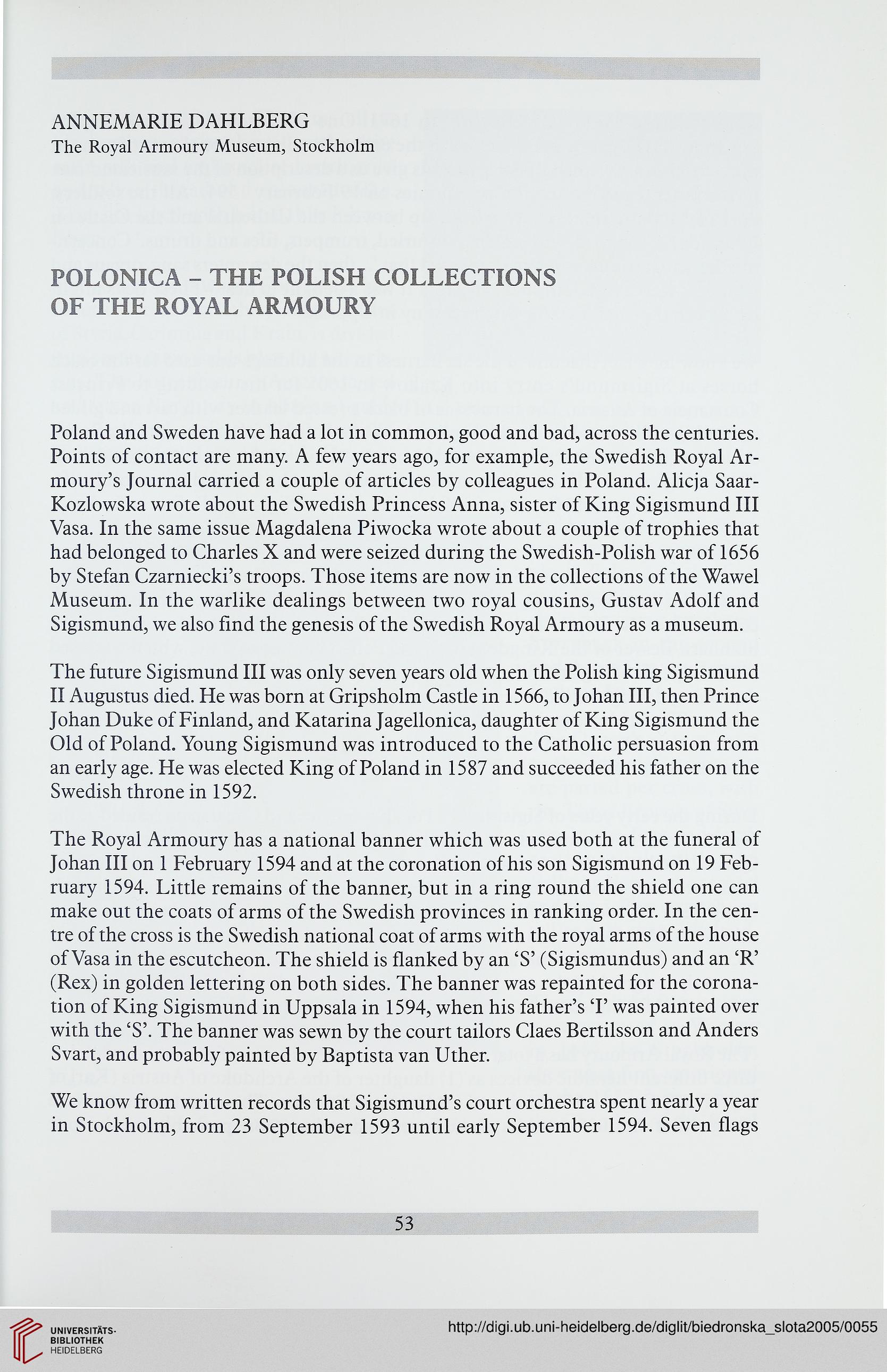ANNEMARIE DAHLBERG
The Royal Armoury Museum, Stockholm
POLONICA - THE POLISH COLLECTIONS
OF THE ROYAL ARMOURY
Poland and Sweden have had a lot in common, good and bad, across the centuries.
Points of contact are many. A few years ago, for example, the Swedish Royal Ar-
moury^ Journal carried a couple of articles by colleagues in Poland. Alicja Saar-
Kozlowska wrote about the Swedish Princess Anna, sister of King Sigismund III
Vasa. In the same issue Magdalena Piwocka wrote about a couple of trophies that
had belonged to Charles X and were seized during the Swedish-Polish war of 1656
by Stefan Czarniecki's troops. Those items are now in the collections of the Wawel
Museum. In the warlike dealings between two royal cousins, Gustav Adolf and
Sigismund, we also fmd the genesis of the Swedish Royal Armoury as a museum.
The futurę Sigismund III was only seven years old when the Polish king Sigismund
II Augustus died. He was born at Gripsholm Castle in 1566, to Johan III, then Prince
Johan Duke of Finland, and Katarina Jagellonica, daughter of King Sigismund the
Old of Poland. Young Sigismund was introduced to the Catholic persuasion from
an early age. He was elected King of Poland in 1587 and succeeded his father on the
Swedish throne in 1592.
The Royal Armoury has a national banner which was used both at the funeral of
Johan III on 1 February 1594 and at the coronation of his son Sigismund on 19 Feb-
ruary 1594. Little remains of the banner, but in a ring round the shield one can
make out the coats of arms of the Swedish provinces in ranking order. In the cen-
trę of the cross is the Swedish national coat of arms with the royal arms of the house
of Vasa in the escutcheon. The shield is flanked by an 'S' (Sigismundus) and an 'R'
(Rex) in golden lettering on both sides. The banner was repainted for the corona-
tion of King Sigismund in Uppsala in 1594, when his father's T was painted over
with the 'S\ The banner was sewn by the court tailors Claes Bertilsson and Anders
Svart, and probably painted by Baptista van Uther.
We know from written records that Sigismund's court orchestra spent nearly a year
in Stockholm, from 23 September 1593 until early September 1594. Seven flags
53
The Royal Armoury Museum, Stockholm
POLONICA - THE POLISH COLLECTIONS
OF THE ROYAL ARMOURY
Poland and Sweden have had a lot in common, good and bad, across the centuries.
Points of contact are many. A few years ago, for example, the Swedish Royal Ar-
moury^ Journal carried a couple of articles by colleagues in Poland. Alicja Saar-
Kozlowska wrote about the Swedish Princess Anna, sister of King Sigismund III
Vasa. In the same issue Magdalena Piwocka wrote about a couple of trophies that
had belonged to Charles X and were seized during the Swedish-Polish war of 1656
by Stefan Czarniecki's troops. Those items are now in the collections of the Wawel
Museum. In the warlike dealings between two royal cousins, Gustav Adolf and
Sigismund, we also fmd the genesis of the Swedish Royal Armoury as a museum.
The futurę Sigismund III was only seven years old when the Polish king Sigismund
II Augustus died. He was born at Gripsholm Castle in 1566, to Johan III, then Prince
Johan Duke of Finland, and Katarina Jagellonica, daughter of King Sigismund the
Old of Poland. Young Sigismund was introduced to the Catholic persuasion from
an early age. He was elected King of Poland in 1587 and succeeded his father on the
Swedish throne in 1592.
The Royal Armoury has a national banner which was used both at the funeral of
Johan III on 1 February 1594 and at the coronation of his son Sigismund on 19 Feb-
ruary 1594. Little remains of the banner, but in a ring round the shield one can
make out the coats of arms of the Swedish provinces in ranking order. In the cen-
trę of the cross is the Swedish national coat of arms with the royal arms of the house
of Vasa in the escutcheon. The shield is flanked by an 'S' (Sigismundus) and an 'R'
(Rex) in golden lettering on both sides. The banner was repainted for the corona-
tion of King Sigismund in Uppsala in 1594, when his father's T was painted over
with the 'S\ The banner was sewn by the court tailors Claes Bertilsson and Anders
Svart, and probably painted by Baptista van Uther.
We know from written records that Sigismund's court orchestra spent nearly a year
in Stockholm, from 23 September 1593 until early September 1594. Seven flags
53




